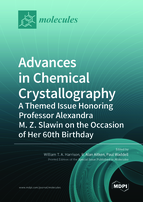Advances in Chemical Crystallography: A Themed Issue Honoring Professor Alexandra M. Z. Slawin on the Occasion of Her 60th Birthday
A special issue of Molecules (ISSN 1420-3049).
Deadline for manuscript submissions: closed (30 September 2021) | Viewed by 33645
Special Issue Editors
Interests: synthetic and structural inorganic chemistry
Interests: synthesis; synthetic use of flash vacuum pyrolysis; heterocyclic chemistry; reactive intermediates; organophosphorus; organosulfur; heavier main group chemistry
Interests: X-ray diffraction; spectroscopic techniques; structure-function relationships; optoelectronic materials; intermolecular interactions; physical properties; supramolecular environments
Special Issue Information
Dear Colleagues,
Molecules is delighted to host a Special Issue honouring Prof. Alexandra Slawin FRSE on her 60th birthday for her outstanding contributions to chemical crystallography, including teaching and instrumentation. Alex was educated at Imperial College London (BSc) and Loughborough University (PhD), and since 2004, she has been a Research Professor of Chemistry at the University of St Andrews (Scotland).
The diffraction facility overseen by Prof. Slawin at St Andrews is amongst the finest in the world, with two rotating anode systems with state-of-the-art area detectors and a fully automated system, which was developed in house and allows non-experts to submit samples which are examined, measured, solved, refined and the results emailed to the researcher.
Alex’s productivity is legendary, and in a survey carried out by the Cambridge Structural Database in 2018, she was ranked 6th in the world for the number of datasets deposited in the CSD and the highest-ranked female. The Web of Science (November 2020) shows her to have 1362 publications, 38,470 citations and a Hirsch h-index of 86. Her papers cover numerous areas of chemistry, including porous materials, metal–organic frameworks, verifying organic mechanisms and total syntheses, main-group chemistry and materials chemistry, and her co-authors include three Nobel prize winners.
It is a grave concern that crystallography (the most powerful and versatile characterisation technique available) is disappearing from many chemistry degrees, and one especially outstanding aspect of Alex’s activities is her commitment to teaching the practice and theory of the technique to undergraduates and the support that she offers to project students. She is fully committed to diversity and supporting the career development of women scientists.
We wish Alex a happy 60th birthday and many more years of productive and ground-breaking science!
Prof. Dr. William T. A. Harrison
Dr. R. Alan Aitken
Dr. Paul Waddell
Guest Editors
Manuscript Submission Information
Manuscripts should be submitted online at www.mdpi.com by registering and logging in to this website. Once you are registered, click here to go to the submission form. Manuscripts can be submitted until the deadline. All submissions that pass pre-check are peer-reviewed. Accepted papers will be published continuously in the journal (as soon as accepted) and will be listed together on the special issue website. Research articles, review articles as well as short communications are invited. For planned papers, a title and short abstract (about 100 words) can be sent to the Editorial Office for announcement on this website.
Submitted manuscripts should not have been published previously, nor be under consideration for publication elsewhere (except conference proceedings papers). All manuscripts are thoroughly refereed through a single-blind peer-review process. A guide for authors and other relevant information for submission of manuscripts is available on the Instructions for Authors page. Molecules is an international peer-reviewed open access semimonthly journal published by MDPI.
Please visit the Instructions for Authors page before submitting a manuscript. The Article Processing Charge (APC) for publication in this open access journal is 2700 CHF (Swiss Francs). Submitted papers should be well formatted and use good English. Authors may use MDPI's English editing service prior to publication or during author revisions.









